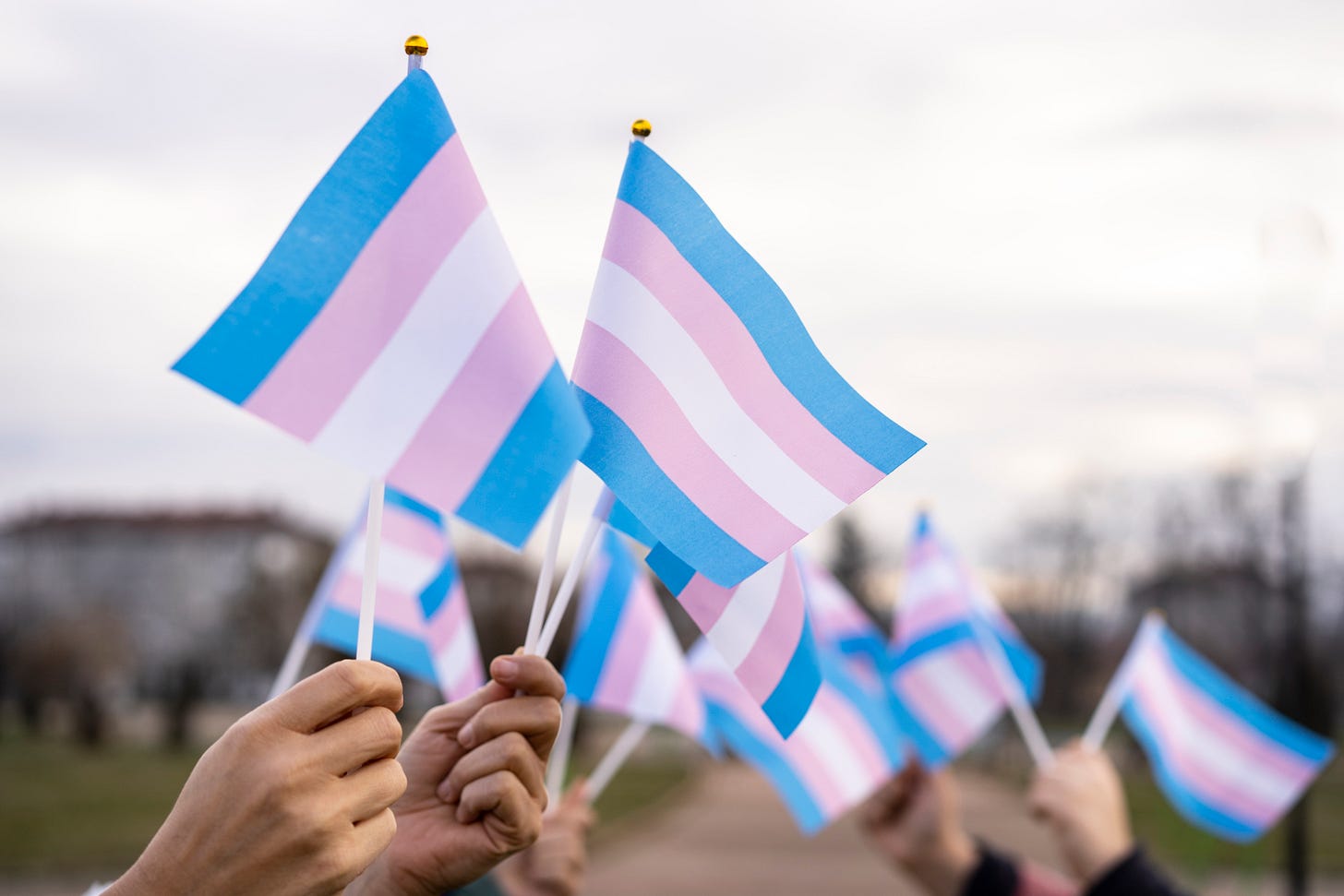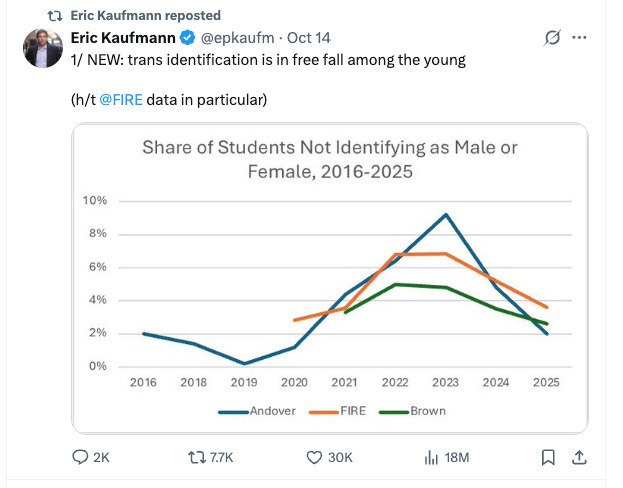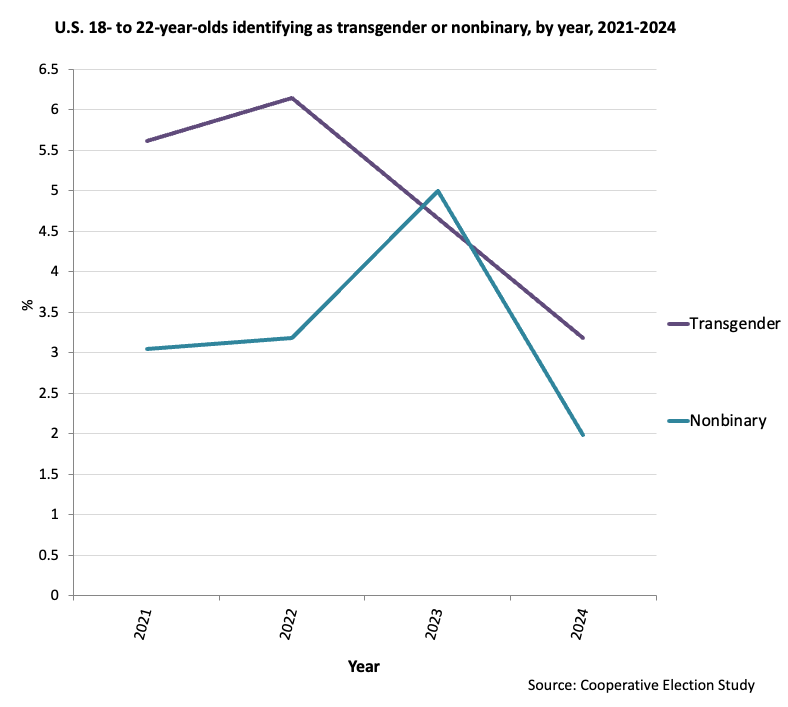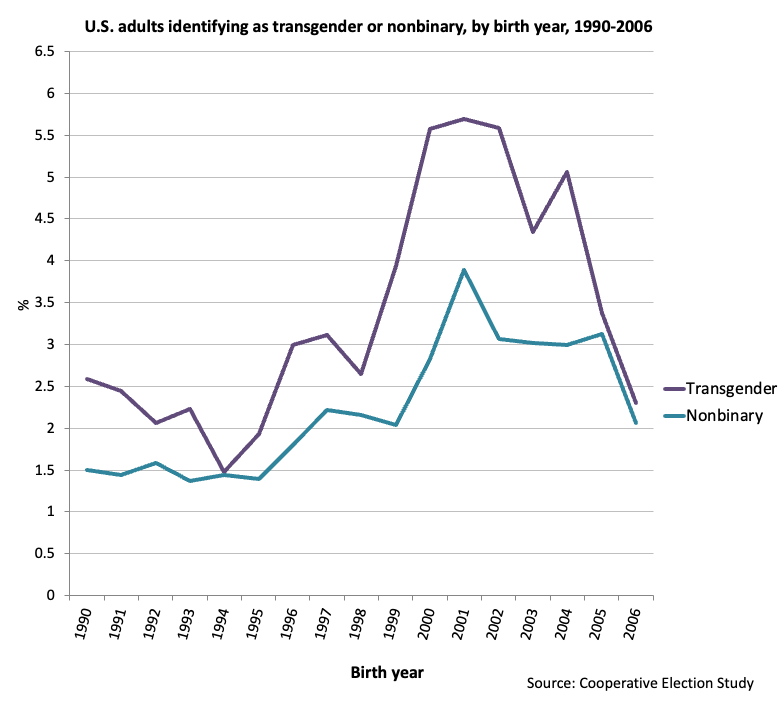Transgender Identity Really Has Fallen Among Young People
Regardless of your politics, here are the facts.
A firestorm erupted last week when the British professor and commentator Eric Kaufmann made a bold claim: Identifying as transgender is “in free fall among the young.”
But as journalist Benjamin Ryan rightly pointed out, the surveys Kaufmann referenced didn’t measure identifying as transgender. Instead, they measured identifying as nonbinary (note the chart says “not identifying as male or female,” which is not the same as identifying as transgender). Another journalist, Erin Reed, criticized Kaufmann’s analysis for not using survey weights. Kaufmann has since responded to both critiques.
Wondering which side was right, last week I analyzed data from the nationally representative Household Pulse survey, which asked directly about transgender identity. It is also a better population-wide indicator than the elite schools used in Kaufmann’s graph. The Household Pulse data showed a decline in trans identification among 18- to 22-year-olds in 2024, but I was cautious about drawing conclusions from it as the decline appeared only in a limited time period (July to September) and two of the three survey administrations added an option for nonbinary identification that wasn’t there before. Maybe that was why identifying as transgender declined.
Then, over the weekend, I found it—a nationally representative survey that asked the same question about transgender identification from 2021 to 2024. It also asked separately about identifying as nonbinary.
The data are from the Cooperative Election Study (CES), fielded each year by YouGov and administered by Tufts University. They show that identifying as transgender really is in free fall among the young in the United States. So is identifying as nonbinary. In other words, Kaufmann was right (with what some consider the wrong data, but still right).
Among 18- to 22-year-olds, trans identification fell by nearly half from 2022 to 2024. Nonbinary identification dropped by more than half between 2023 and 2024:
Year of birth plays a key role here. Americans born in the early 2000s were more likely to identify as transgender than those born before or after them. That was also true for identifying as nonbinary, though with a less pronounced up and down pattern:
One caveat: We don’t have 2025 data from the CES yet, so we can’t tell if this trend will continue. CES is partially funded by the National Science Foundation, so it’s possible the survey will not ask about or report data on transgender or nonbinary identification this year due to the Trump administration’s mandate on not acknowledging gender identity.
I hope they do, though, as that will be the only way to know that the 2024 data aren’t a blip.
Jean M. Twenge is Professor of Psychology at San Diego State University and the author of Generations: The Real Differences between Gen Z, Millennials, Gen X, Boomers and Silents—and What They Mean for America’s Future and 10 Rules for Raising Kids in a High-Tech World.
A version of this article originally appeared on Jean Twenge’s Generation Tech Substack.
Follow Persuasion on Twitter, LinkedIn, and YouTube to keep up with our latest articles, podcasts, and events, as well as updates from excellent writers across our network.
And, to receive pieces like this in your inbox and support our work, subscribe below:









So, Democrats, what this means (should you be interested in truth) is:
1. You weren’t liberating them..
2. You were creating them…
3. Because you are the taste makers…
4. You are the Influencers..
5. Your self conception is flawed…
6. You feel like your cultural capital is spent on liberation…
7. But it’s really spent on fad creation
Progressives - update your priors. You ARE the culture. You no longer liberate, you create.
Be more thoughtful (and less arrogant) about the genuine effect you have on our people through your art, music, and media.
Decades ago, Americans became acquainted with the term "copycat crime" and the potential effect of news reports on people who were already in a precarious psychological state. Later came the tragic period of teenage suicide clusters (not pacts, but successive instances within a single community). We learned to think about something called "social contagion" and to seek precautions against it. This was a perfectly progressive way to think. Everyone recognized at once that adolescents were the people most vulnerable to such a phenomenon.
Then came heavily-funded advocacy for (among items on the trans activist agenda) letting adolescents undergo a sexual transition without a waiting period. Progressive circles became uncritically trans-positive in all things. Suddenly, the subject of social contagion was taboo. It might take some of the wind out of activists' sails (and out of providers' incomes), and so it was stigmatized. We were supposed to believe, fantastically, that a young person's self-identification as trans (or non-binary) *couldn't* be due to a peer-group fad.
Now we're going to get some idea how many of those self-IDs were stable, how many were fleeting, and how much irreparable harm has been done by trans maximalism.